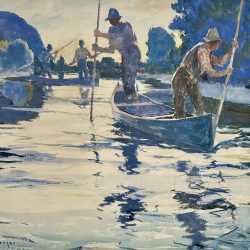Filter by Type
Filter by Category
Filter by Size
Filter by Year

Frank Benson
American (1862-1951)
Frank Weston Benson was born in Salem, Massachusetts in 1862. Along with a distinguished class that included Edmund Tarbell, Philip Little, Robert Reid, Walter Griffin and Joseph Lindon Smith, he studied at the School of Drawing and Painting at the Museum of Fine Arts, Boston. He produced his first etching, “Salem Harbor,” as the frontispiece for the school magazine he helped to edit. Benson soon turned his focus to painting, eventually becoming a well-established and wealthy painter. He produced somber New England oil portraits as well as popular impressionistic oils and watercolor scenes of women and children. Both of these categories mentioned varied greatly from his later print work subjects of waterfowl and hunting. Benson achieved prominence as a founding member of the Ten American Painters Group, and also as head of the painting department at the MFA school. Notably, the artist assumed the latter position only eight years after graduating from the same institution.
Despite his active involvement in the New England painting scene, Benson’s early painting success is often overshadowed by his later print work. At age 50, Benson turned to etching, while at the height of his painting popularity. His first experimental exhibition in the Guild of Boston Artist’s Show created instant demand for more prints. The most celebrated subjects in this first show were waterfowl and hunters. This success undoubtedly formed a direction for Benson’s work, as most of his print subjects fell in those categories. The artist helped to establish sporting prints as a popular American genre with his insightful, observant prints. In the thirty years following his print exhibition, 1912 – 1942, Benson created over 350 etchings and drypoints of such individuality, force, and quality that he ranks as one of the most important American artists of his generation.










![Drawing by Frank Benson: [Salmon Fishing Scene], available at Childs Gallery, Boston](https://childsgallery.com/wp-content/uploads/frank-benson_salmon-fishing-scene_childs_gallery_12467-250x250.jpg)